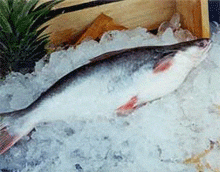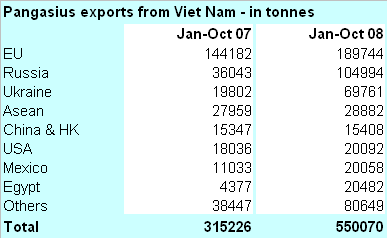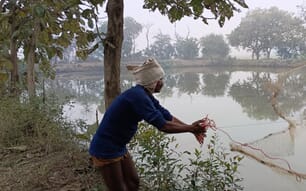Vietnamese pangasius still in a bonanza phase...
Pangasius exports increased by 53 per cent in value and 75 per cent in quantity over the same period of 2007. At these rates, pangasius recorded the highest growth rate of any aquaculture product exported by Viet Nam. The country is earning average revenue of USD 150 million from pangasius exports a month and total 2008 exports are expected to be USD 1.5 billion.

These forecasts should be reasonable, as new markets such as Russia, the Middle East and some Asian countries have demonstrated a growing demand for pangasius imported from Viet Nam. Russia is by far the main importing country of pangasius from Viet Nam, representing alone some 20 per cent of total exports. This country reported a 191 per cent growth in imports of pangasius from Viet Nam in the first ten months of 2008. Ukraine is second major outlet for Vietnamese pangasius, with 13 per cent of total imports. Ukraine imports of pangasius grew even stronger than the ones of Russia: from 20 000 tonnes in Jan-Oct 2007 to 70 000 tonnes in Jan-Oct 2008. Egypt also expanded as one of the main outlets for this commodity.
The EU is the main common market for pangasius from Viet Nam, with about one third of imports in both quantity and value terms. Spain is the biggest market, growing by 8 per cent. Demand for pangasius from the European market usually increases every year starting at the end of September.

... but there are some clouds on the bright sky
Despite this phenomenal growth rates, there is also some critics to be heard. On the one hand, the Vietnamese industry suffers from missing storage space. At present, Vietnamese traders have to sell at whatever price, so they are unable to wait for higher prices. In order to increase the present coldstorage capacity to some 10 000 tonnes, 1.1-1.5 million EUR would be needed, difficult to mobilize in the present difficult financial situation. In addition to upgrading infrastructure, aquaculture companies have invested in widening their material areas. They signed contracts with local farmers to supply them with food and breeding fish to guarantee their supply.
Price cuts are to the expense of quality. Huge price competition result in an overuse of glazing and additives. This will result in declining quality and in the long in consumer dissatisfaction. As for all other major seafood items, importers will start to control more the quality offered, and establish good working relationships with trustworthy companies in Viet Nam. There will a shake out of the industry in the coming year.
The Vietnamese government animates pangasius producers to agree upon a floor price to avoid unfair competition, while ensuring hygienic practices. Recently, many aquaculture processing companies in the Cuu Long Delta have invested in upgrading their infrastructure and expanding their production.
Imports of pangasius are up 90 per cent into Germany in the first six months of 2008 compared to 2007. The species is being used in more ways by German companies, including the organic range as well as introducing some high-end smoked products. In October 2008, a consumer journal enquiry found several problems with pangasius products in German supermarkets. The impact of this study on German pangasius consumption has still to be seen.
The US catfish market is growing quite impressively. In the first nine months of 2008, some 37 000 tonnes were imported, 25 per cent more than in the same period of last year. Viet Nam accounts for about half of this quantity, while China reported strong increase in its catfish supplies to the US market, after the tough controls enforced last year. At present China accounts for about 27 per cent of total US catfish imports.
2009 year of change
Vietnamese pangasius producers have to improve their quality and their business practices, in order to maintain their markets in Europe. Overall, 2009 will be an important year for the industry, moving from a booming industry into a more mature phase. The occasional quality problems, as the ones listed by the German journal will lead to more consumer resistance. The low price alone will not be able to maintain the EU market.
February 2009



